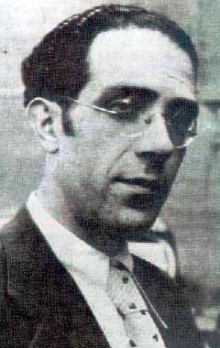Jesús Hernández Tomás facts for kids
Quick facts for kids
Jesús Hernández Tomás
|
|
|---|---|
 |
|
| Minister of Education and Fine Arts | |
| In office 4 September 1936 – 17 May 1937 |
|
| Preceded by | Francisco Barnés Salinas |
| Succeeded by | Segundo Blanco |
| Minister of Education and Health | |
| In office 17 May 1937 – 5 April 1938 |
|
| Preceded by | Federica Montseny (Health) |
| Succeeded by | Segundo Blanco |
| Personal details | |
| Born | 1907 Murcia |
| Died | 11 January 1971 Mexico |
| Nationality | Spanish |
| Occupation | Politician |
Jesús Hernández Tomás (born in 1907 – died on January 11, 1971) was an important Spanish politician. He was a leader in the Communist Party of Spain. During the Spanish Civil War (1936–1939), he served as a government minister. First, he was the Minister of Education and Fine Arts. Later, he became the Minister of Education and Health. After the war, he had to leave Spain and lived in different countries, including Mexico. He was later no longer part of his political party. This happened after he wrote a book in 1953 that criticized some of the party's actions during the Civil War.
Contents
Early Life and Political Start
Jesús Hernández Tomás was born in Murcia, Spain, in 1907. He helped start the Communist Party in the Biscay region of Spain.
In 1922, he worked with Óscar Pérez Solís, who was a leader of the Spanish Communist Party. Hernández was arrested in 1929 but was released the next year. Around 1931, when the Second Spanish Republic began in Spain, Hernández traveled to the Soviet Union. There, he studied at a special school in Moscow called the Leninist School.
In 1932, the Spanish Communist Party changed its main goal. Instead of focusing on a "Workers' and Peasants' Government," they decided to "Defend the Republic." Hernández Tomás became one of the new leaders of the party. Other new leaders included José Díaz and Vicente Uribe. That same year, Hernández became a member of the party's main committee, in charge of spreading their ideas. He returned to Spain in 1933 and became the editor of the party's newspaper, Mundo Obrero (Worker's World).
Role in the Spanish Civil War
In the 1936 elections, Hernández was chosen as a representative for the Cordoba area. The Spanish Civil War started soon after these elections. On August 8, 1936, Hernández clearly stated that a big worker's revolution was not possible in Spain at that time.
On September 4, 1936, President Francisco Largo Caballero appointed Hernández as the Minister of Education and Fine Arts.
Government Changes
President Largo Caballero faced challenges and felt isolated. By February 1937, he asked his ministers, especially the communist ones like Vicente Uribe and Jesús Hernández, to confirm their support for him.
On May 15, 1937, Uribe and Hernández caused Largo Caballero's government to fall apart. This happened because of a disagreement about the May Days violence in Barcelona. The communists blamed anarchist groups and another political party called the POUM for the violence. They wanted the POUM to be banned and its leaders arrested. Largo Caballero refused, and many ministers left the meeting.
On May 17, 1937, a new President, Juan Negrín, appointed Hernández as the Minister of Education and Health. Hernández started new programs that focused on education as an important part of society.
Hernández was replaced by Segundo Blanco in April 1938. After this, he became a political leader in the South Central area of Spain. When the Republican forces lost the Battle of the Ebro (July–November 1938), Hernández stayed in Madrid with other party leaders. He later took on a leading role in the party. However, he had to leave Madrid after a military takeover in March 1939.
Life After the War
After the Republican government fell in March 1939, Hernández went to live in Oran, a city in Algeria, and then in Moscow, the capital of the Soviet Union. He was chosen to be part of an important international communist committee.
In 1943, he was sent to Mexico. In 1944, he was no longer part of the Spanish Communist Party because of disagreements with the party's leaders.
In 1953, Hernández published a book about the Civil War called Yo fui ministro de Stalin (I Was Stalin's Minister). The book was also published in French as La Grande trahison (The Great Betrayal). In this book, he shared details about events during the war, including how a political leader named Andrés Nin was tortured and killed. The book also talked about other ways that Soviet leaders influenced the war.
In 1953, Hernández started a new, short-lived political group called the Independent Communist Party. This party was based in Bucharest, Romania. After this party ended, he left politics and returned to Mexico, where he lived until he passed away in 1971. His name was left out of the official history of the Spanish Communist Party that was published in 1960.
Images for kids
Sources
See also
 In Spanish: Jesús Hernández Tomás para niños
In Spanish: Jesús Hernández Tomás para niños


